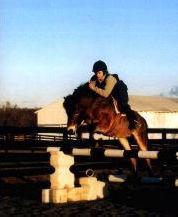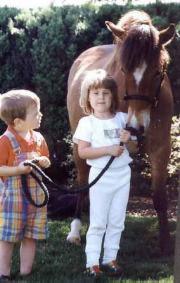|
|

The stallion Direktor Dubbe, imported from
Gotland, is an excellent example of the gentle but strong Gotland breed with
superb gaits, movement and temperament |
The
Gotland Pony |
In Sweden, on the island of Gotland in the
Baltic Sea, lives a herd of semi-wild horses, the Gotland Pony or 'Russ', as
they are called locally. The breed has lived in isolation and has kept its
moderate size and attractive, relatively primitive look since the Stone-Age.
History of the Gotland pony
Findings from about 3,000 B.C. show that the
early man kept Gotland horses in a semidomestic fashion, using them to perform
various tasks as well as for food.

Photography by Haakan Hollstroem |
In the beginning of the 19th
century the Russ could be found throughout Gotland. When farmers claimed the
formerly 'public' land and established property boundaries, many Russ were
rounded up and exported to Belgium, England and Germany, where they readjusted
to new lives, often as cart ponies or in coal-mines.
|
Because the Russ are
easy-keepers, versatile and strong in relation to their size (11.2 to 13
hands), these handy little ponies were a popular export at the turn of the
century -so popular, in fact, that they almost became extinct in Sweden at this
time. Around 1880, 11,500 Russ roamed the moors of Gotland. By 1930, there were
only 30 active broodmares.
|

Photography by Haakan Hollstroem |
The Russ Today
Today, planned breeding and cooperation between
breeders on Gotland and the mainland of Sweden have helped re-establish the
breed. When inbreeding threatened the Gotland's very existence, new blood,
carefully selected, helped revitalize the breed, including a Syrian stallion in
1886 and two Welsh stallions in the early 1950s.

Photography by Haakan Hollstroem |
Local farmers, breeders and the
Gotland Agricultural Society still own and maintain a herd of about 150 Russ on
the moors of Lojsta in the southern part of Gotland, where the society keeps
records. Even though the Russ live in relative freedom, they are overseen with
a watchful eye: a caretaker visits the herd almost daily and, in winter,
supplements their forage with feed every other day. |
A few times each year the ponies are rounded up
for hoof trims and checked for overall health and well-being. Each season is
marked by an annual Gotland activity: there's releasing the stallion to the
herd each June, judging in July, and weaning the foals from the mares in
November.

Photography by Haakan Hollstroem |
It is truly an unforgettable
experience to walk in the forest and encounter a pair of wild Russ mares with
their foals. If you sit still, the foals may come up to sniff you while the
watchful but calm mothers keep an eye on you from a distance! |
| The mostly brown coloring of
the Russ camouflage them well, but if you are patient and quiet, you will see
the whole herd materialize from behind the pines and brush. It is a
horse-lover's ultimate nature experience! |

Photography by Haakan Hollstroem |
Russ Characteristics
The Russ is strong, healthy and long-lived
(many live into their thirties!), energetic, intelligent and friendly.
 |
Gotlands make a perfect first
mount, as Lisa on Minessa discovers.
Gotlands where the first mounts for the Swedish
Crown Princess Victoria as well as Olympic Dressage competitor and medalist
Ulla Haakanson. |
In Sweden these versatile
ponies reap great success in the show ring as well as in three-day eventing,
show-jumping, dressage, driving, and harness racing. (No other horse of
comparable size can out-trot a Russ!) A 12 year old Gotland mare, Snaeckan,
holds the world record for harness racers category B (ponies up to 130 cm).
Photo right: Direktor Dubbe, owned by Gunilla
Combs and ridden by Jessica Smith, is the first ever Gotland Stallion approved
for breeding by the Swedish Russ Breeder's Association to stand in the United
States. |
 |
 |
The Russ is a great companion,
for young and old alike. Because of its longevity, versatility and friendly
disposition, a Gotland pony is sure to become a family favorite. They are
curious, brave, people-oriented, even-tempered, and quick to learn
Gotland ponies, with their gentle temperament and
small size, are ideal for children of all ages. Because of their longevity, the
same Russ can teach as many as three generations! Gotland ponies are also
easy-keepers who love the outdoors. They are strong, energetic, intelligent and
friendly. |
The Gotland breed has steadily gained popularity
in North America, and a breed association, the Gotland Russ Association of
North America (GRANA) was formed in 1997 in order to preserve, protect, and
promote the Gotlands on this continent. Since 1999, GRANA has been affiliated
with the Swedish Russ Breeder's Association (SvRAF) and now follows the same
strict guidelines for breeding and inspections to maintain the high quality of
the breed. GRANA also runs the North American Registry for Gotlands, and
currently registers around 20 foals every year. The total number of Gotlands in
North America is steadily growing and is now nearing 200. GRANA currently has
21 active members, and publishes a quarterly newsletter.
|

